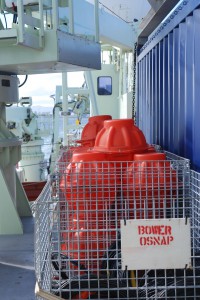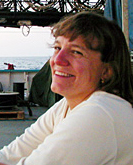Work continued around the Knorr today as the various groups from the U.S., U.K. and the Netherlands loaded their oceanographic instruments on board and began assembling the deep-sea moorings. The moorings typically consist of several very long pieces (called “shots”) of wire rope that are shackled together to make one long string that might be 1-2 miles long. Then instruments that measure temperature, salinity and current speed are attached to the wire as the wire is let out over the stern of the ship. At the very end, an extremely heavy anchor is attached, and the anchor is slid off the stern (back end) of the ship. The anchor sinks quickly to the sea floor, pulling all the attached instruments down. But the whole string is held up by lots of glass and syntactic foam spheres. This keeps the string oriented upright in the water. When we come back next year to recover the mooring and set a new one, we will send an acoustic signals to a device just above the anchor that says, “let go of the anchor!” When that happens the glass and foam spheres cause the whole string to float to the sea surface where we can pick it up from the ship. All the data that was collected over the previous year is downloaded to a PC. The instruments get reset with new batteries and are set out on a mooring for another year. This kind of deep-sea mooring has been around for decades, although the instruments now have microprocessors (a mini computer) inside for recording data.
I mostly stayed out of the way of the loading because it involves fork lift trucks, cranes and large, heavy swinging objects. I now have my computer work station set up, which is my “eye” on the world. I use a laptop with a screen reader (Jaws) and screen magnifier (Magic) to do almost all of my work, check e-mail and write this blog. The screen reader makes the computer say out loud everything I type or want to read. It’s super fantastic and a “must-have” tool for a blind or visually impaired scientist.


 Amy Bower is a physical oceanographer at the Woods Hole Oceanographic Institution. She has been chasing ocean currents in the Atlantic and Indian Oceans for over 25 years, primarily by releasing acoustically tracked floats far below the sea surface. Legally blind since her mid-20s, Amy uses adaptive technology to continue her research.
Amy Bower is a physical oceanographer at the Woods Hole Oceanographic Institution. She has been chasing ocean currents in the Atlantic and Indian Oceans for over 25 years, primarily by releasing acoustically tracked floats far below the sea surface. Legally blind since her mid-20s, Amy uses adaptive technology to continue her research.